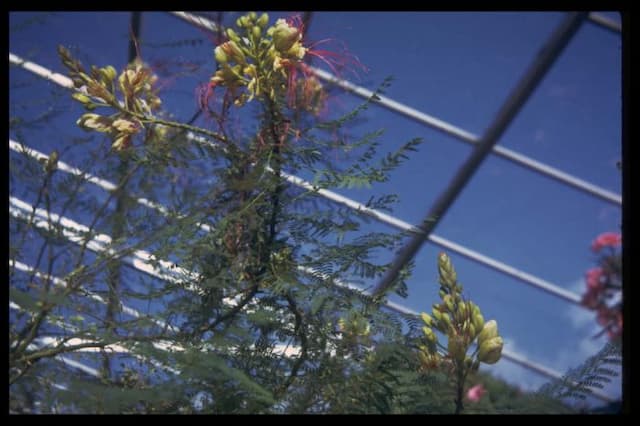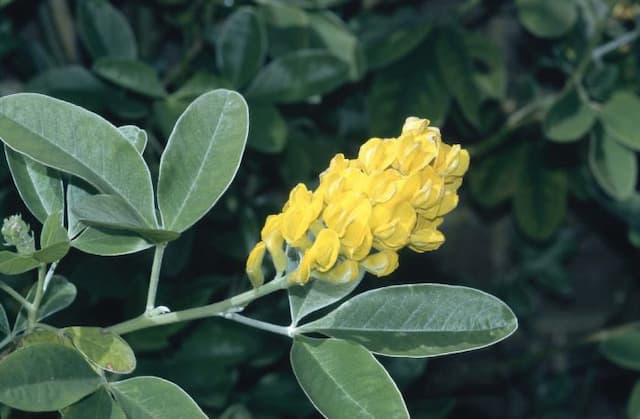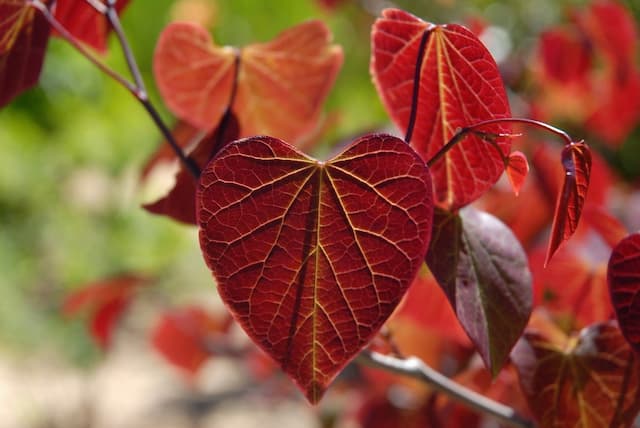False indigo Amorpha fruticosa

ABOUT
The plant commonly known as false indigo bush, presents a striking appearance with its dense clusters of small, purple-blue flowers. Each flower has a unique structure, with a single, prominent petal and protruding stamens that add to its appeal. These nectar-rich blooms are a magnet for pollinators such as bees and butterflies. The plant's leaves are compound, arranged in alternative patterns along the branches, and each leaflet is small and oval-shaped with a smooth edge, offering a lush, green backdrop that makes the flowers stand out even more. Branching out, the bush has a rounded and bushy appearance with stems that can have a reddish tinge. The bark of the mature plant is typically gray and may appear furrowed. In the fall, the foliage can turn to a yellowish color, adding to the seasonal display of the landscape. Additionally, after flowering, the plant develops seed pods that are visually interesting. These pods are small and dark, giving the plant ongoing visual interest even after the blooming period has passed. Overall, the false indigo bush is a plant with a diverse array of features that contribute to its aesthetic appeal in a garden or natural setting.
About this plant
 Names
NamesFamily
Fabaceae.
Synonyms
False Indigo, Desert False Indigo, Bastard Indigobush, Indigo Bush, False Indigo Bush, Leadplant, Prairie Shoestring.
Common names
Amorpha angustifolia, Amorpha arborescens, Amorpha bushii, Amorpha curtissii, Amorpha dewinkeleri, Amorpha fruticosa var. angustifolia, Amorpha fruticosa var. bushii, Amorpha fruticosa var. occidentalis, Amorpha occidentalis, Amorpha virgata.
 Toxicity
ToxicityTo humans
The plant known as indigo bush (Amorpha fruticosa) is not widely recognized as having significant toxic effects on humans when touched or ingested in typical amounts. However, like many plants, it may cause mild stomach upset or an allergic reaction in sensitive individuals if parts of the plant are ingested. It is always wise to exercise caution and avoid eating plants that are not commonly recognized as food sources. There is no well-documented case of poisoning in humans from the indigo bush.
To pets
Indigo bush (Amorpha fruticosa) is not commonly known as a toxic plant to pets. However, individual animals might have sensitivities or allergies to plants that are not typically considered poisonous. If a pet were to ingest a significant amount of the indigo bush, they might experience mild gastrointestinal upset such as vomiting or diarrhea. As with any non-food plant, it is best to prevent pets from ingesting it to avoid any potential adverse effects. If you suspect your pet is showing symptoms after consuming the plant, it is advisable to contact a veterinarian.
 Characteristics
CharacteristicsLife cycle
Perennials
Foliage type
Deciduous
Color of leaves
Green
Flower color
Purple
Height
5-12 feet (1.5-3.6 meters)
Spread
6-15 feet (1.8-4.6 meters)
Plant type
Shrub
Hardiness zones
4-9
Native area
North America
Benefits
 General Benefits
General Benefits- Erosion Control: Amorpha fruticosa, commonly known as false indigo bush, has a robust root system that stabilizes soil and prevents erosion, particularly useful in riparian zones.
- Habitat for Wildlife: It provides shelter and food for various wildlife species, including pollinators like bees and butterflies, as well as birds that feed on its seeds.
- Ornamental Use: False indigo bush offers aesthetic appeal with its attractive foliage and spikes of purple flowers, making it popular in naturalistic landscaping and garden design.
- Nitrogen Fixation: Like many legumes, it adds nitrogen to the soil through a symbiotic relationship with bacteria, improving soil fertility for surrounding plants.
- Soil Improvement: The plant's decomposition adds organic matter to the soil, enhancing its structure and nutrient content.
- Tolerance to Adverse Conditions: It is drought-resistant and can thrive in various soil types, making it suitable for xeriscaping and restoration projects in challenging environments.
 Medical Properties
Medical Properties- Anti-inflammatory: Amorpha fruticosa contains compounds that may help reduce inflammation.
- Antioxidant: The plant has antioxidant properties, potentially mitigating oxidative stress and damage.
- Antimicrobial: Extracts from Amorpha fruticosa have shown activity against certain bacteria and fungi.
- Hepatoprotective: There is evidence to suggest that Amorpha fruticosa may offer some protection to the liver against certain toxins.
 Air-purifying Qualities
Air-purifying QualitiesThis plant is not specifically known for air purifying qualities.
 Other Uses
Other Uses- Soil Erosion Control: Amorpha fruticosa, also known as false indigo bush, has a root system that helps stabilize soil, making it ideal for preventing erosion on slopes and riverbanks.
- Dye Production: The plant has been historically used to produce a blue dye, which though not as potent as true indigo, served as a substitute for it.
- Insectary Plant: False indigo bush attracts beneficial insects to the garden, such as predators and pollinators, due to its nectar-rich flowers.
- Bioremediation: The species can be used in phytoremediation projects to help clean up areas contaminated with heavy metals, thanks to its high tolerance and accumulation ability.
- Fodder: While not a primary choice for fodder, the plant can be consumed by livestock, especially goats, and may be used as a supplemental forage resource.
- Nitrogen Fixation: As a legume, false indigo bush improves soil fertility by fixing atmospheric nitrogen, benefiting neighboring plants in agroforestry systems.
- Windbreak: Its dense growth habit allows it to serve as an effective windbreak, protecting nearby crops or residential areas from wind erosion and damage.
- Wildlife Habitat: Amorpha fruticosa provides shelter and nesting sites for various wildlife species, including birds and small mammals.
- Streambank Plantings: The plant is used in streambank restoration projects to stabilize banks and provide habitat for aquatic organisms.
- Decorative Uses: Its showy purple flowers and interesting foliage make the false indigo bush a choice for ornamental use in landscaping.
Interesting Facts
 Feng Shui
Feng ShuiThe False Indigo is not used in Feng Shui practice.
 Zodiac Sign Compitability
Zodiac Sign CompitabilityThe False Indigo is not used in astrology practice.
 Plant Symbolism
Plant Symbolism- Transformation: Amorpha fruticosa, commonly known as false indigo, often symbolizes transformation due to its ability to change the soil composition by fixing nitrogen, which can significantly impact the surrounding plant life and ecosystem.
- Protection: False indigo is known to have a strong, deep root system which suggests stability and protection. This can be symbolic of a person's need to provide a safe haven or protection to others.
 Water
WaterFalse indigo should be watered deeply and slowly to encourage a strong, deep root system; aim to water so that the soil becomes moist but not soggy. During the active growth season in spring and summer, water the plant approximately once a week, providing about 1.5 gallons of water per session for a young plant. Mature false indigos that are established in the landscape may require less frequent watering thanks to their established root systems and can sometimes rely on rainfall, but during prolonged dry spells, additional watering every two weeks may be necessary to maintain plant health. Adjustments should be made according to the specific environmental conditions and soil type.
 Light
LightFalse indigo thrives in full sun to partial shade, making it adaptable to a variety of garden locations. For optimal growth and flowering, a spot that receives at least 6 hours of direct sunlight per day is ideal. However, the plant can also perform well in light partial shade, particularly in areas with scorching summer heat where some afternoon shade can be beneficial.
 Temperature
TemperatureFalse indigo is cold hardy and can tolerate a range of temperatures, generally surviving winter lows down to about -20°F and is comfortable in summer highs up to around 100°F. The ideal temperature for promoting growth and flowering is between 60°F and 85°F. This resilience makes it a favorable choice for gardeners in a wide range of climate zones across the United States.
 Pruning
PruningFalse indigo benefits from pruning primarily to maintain shape and encourage bushier growth. Prune in late winter or early spring before new growth starts. Cut back the plant by about one-third to encourage fresh growth and to prevent it from becoming too leggy. Deadheading, or removing spent flowers, can promote additional blooming and prevent unwanted self-seeding.
 Cleaning
CleaningAs needed
 Soil
SoilFalse indigo prefers well-draining soil with a pH range of 6.0 to 8.0. The best soil mix consists of garden soil, peat, and coarse sand or perlite to ensure proper drainage. Organic matter like compost or aged manure can be added to provide nutrients.
 Repotting
RepottingFalse indigo does not require frequent repotting as it is a large shrub. It may be necessary every 3-4 years if it is grown in a container, to refresh the soil and provide more space for its roots.
 Humidity & Misting
Humidity & MistingFalse indigo is tolerant of a wide range of humidity conditions and does best in average outdoor humidity. It does not have specific humidity requirements and can thrive in both humid and drier environments.
 Suitable locations
Suitable locationsIndoor
Ensure bright light, minimal water, and infrequent repotting.
Outdoor
Plant in sun, ensure drainage, and water sparingly.
Hardiness zone
4-9 USDA
 Life cycle
Life cycleAmorpha fruticosa, commonly known as the False Indigo Bush, begins its life cycle as a seed, which germinates in spring when soil temperatures and moisture levels become conducive for growth. The seedling emerges and establishes a root system while developing its first set of true leaves, gradually maturing into a woody, deciduous shrub. During the growth phase, the False Indigo Bush develops compound leaves and elongated clusters of purple flowers with bright orange anthers that bloom in late spring to early summer, attracting pollinators. After pollination, the plant produces small pods containing seeds that mature by late summer to early fall, which are then dispersed by wind, water, or animals. In the dormant stage during winter, the plant loses its leaves but the roots and stems remain viable. Come the next spring, the cycle starts anew with the sprouting of new shoots and leaves from the perennial rootstock.
 Propogation
PropogationPropogation time
Spring to early summer
False indigo (Amorpha fruticosa) can be propagated by seed, which is the most popular method. The best time to sow seeds is in late fall to early winter, allowing for natural stratification during the cold months. To propagate by seed, first, the hard seed coat should be scarified or scratched to encourage germination. This can be done by gently rubbing the seeds with sandpaper or nicking them with a knife. Once scarified, the seeds are soaked in water for 24 hours to further improve germination rates. After soaking, the seeds are sown directly into the ground or into pots with well-draining soil, covering them with approximately a quarter-inch (about 6 millimeters) of soil. Germination usually occurs in the spring as temperatures rise.









